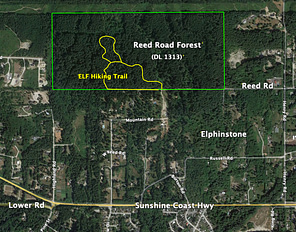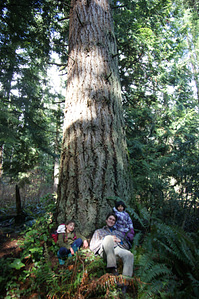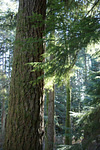Help Protect the Reed Rd Forest Reserve (DL 1313)
Are you tired of seeing the most beautiful examples of coastal forests lost to clearcuts? If so, we need your support in protecting a remarkably beautiful forest in Elphinstone.
District Lot 1313 (identified on the map below) is a 47.75-hectare (118-acre) forest at the end of Reed Road, in Skwxwu7mesh (Squamish) territory, in Elphinstone (SCRD Area E). It is owned by the Province of B.C. and managed by the B.C. Ministry of Forests (FLNRO).
Lot 1313 contains a fabulous low-elevation forest of massive fir trees. Although the trees are only 110 years old, they are as big and gorgeous as any old growth because of the amazing growing conditions on this site. Since the Lot 1313 Forest grew up after the 1904 fire, this natural forest has never been logged. It is an impressive, intact ecosystem filled with diverse flora and fauna typical of the most productive and rarely protected maritime forests. This beautiful forest can, and should be, protected but it is currently under threat of clearcut logging by BC Timber Sales,the government’s own logging company.

SCRD Director for Elphinstone, Lorne Lewis, has engaged the Sunshine Coast Regional District (SCRD) and multiple stakeholders in an ongoing conversation about how to protect the Lot 1313 Forest for some time. As well, forest activists Elphinstone Logging Focus (ELF) have also independently undertaken actions to try to stop BCTS from selling the logging rights to Lot 1313 Forest.
In January 2018, citizens responded to Lorne Lewis’s Call to Action to Protect Lot 1313 and jammed into Frank West Hall in Elphinstone to figure out how to permanently protect Lot 1313. We learned that much work has already been done at the SCRD to keep this forest from being logged, and that there is a real opportunity to have it protected, if we can send a strong message to government right now.
We need your help! We are asking citizens of the Sunshine Coast to come together, write letters to the B.C. Government, and send a strong message that we want to Protect the District Lot 1313 Forest.
We are not asking you to sign a petition or send in a form letter. What we really need is for you to send a personal letter, expressing a clear request and reasons why YOU want to protect the Lot 1313 Forest. Your letter need not be long, unless you want it to be. We have compiled a list of reasons why we think the B.C. Government should protect the lot 1313 Forest and we share it with you to assist your letter writing. Please, feel free to use any of the points below and don’t hesitate to get in touch with us if you have questions or would like support in crafting a letter.
Please send your letter to the people listed below
ABOUT THE FOREST
Lot 1313 is a mature pioneer Douglas-fir forest in a lower-elevation marine (ocean-influenced) setting. It is a highly productive site that illustrates the spectacular beauty of B.C.’s natural coastal forests.
VALUE OF LOT 1313 FOREST AND LOSS TO RESIDENTS AND COMMUNITY IF LOGGED
Habitat: The area is habitat for many species of mammals, amphibians, and birds. Many species rely on this forest and its streams. Logging would destroy this habitat.
Recreation and Enjoyment:
The Lot 1313 Forest is magical and it would be a huge loss if it were to be logged. It is the last bit of easily accessible forest in Elphinstone, close to Gibsons and residential areas.
Many people use the Lot 1313 Forest for hiking, jogging, dog-walking, and horseback riding.
A highly used, downhill mountain bike trail ends at the southeast corner of Lot 1313, which would make a perfect addition to the trail.
There are amazing chanterelle mushroom patches in this forest.
The Lot 1313 Forest provides local residents with a wonderful place to walk and enjoy its beauty and serenity.
Area E needs a park! Unlike West Howe Sound (Area F) and Roberts Creek (Area D), Elphinstone (Area E) contains NO forested parkland. Lot 1313 could be Elphinstone’s park.
This would all be lost if the Lot 1313 Forest is logged.
Drinking Water: The trees in the Lot 1313 Forest are hydrologically important to the streams, creeks, and wells in the area. The watershed protects and governs the water flow to drinking water wells on properties directly below Lot 1313. A Watershed Reserve was established to protect long-term water flows to the drinking water wells of farmers and residents in the area and to keep the wells full during droughts. But the reserve designation does not prevent logging activity that could endanger wells in the area, which is not serviced by regional water. Residents’ drinking water could be compromised or lost.
Flooding Hazards: Logging could create serious hazards of downstream flooding. Area residents have told us that the creek coming out from DL1313 at the southeast corner is prone to flooding, especially if there is heavy rain and previous logging has caused flooding on downstream properties.
Quality of Life: Lot 1313 is literally the backyard of Area E residents. This forest is very close to people’s homes and industrial logging would be extremely disruptive for residents. Impacts on quality of life and enjoyment of property should be considered in forest development planning.
Let’s take a stand for our local forests!
Please address you letter to
Minister of Environment, George Heyman and Minister of Forests, Doug Donaldson
Please send your letter to:
BC Minister of Environment, Honourable George Heyman ENV.Minister@gov.bc.ca <mailto:ENV.Minister@gov.bc.ca>
BC Minister of forests, Honourable Doug Donaldson FLNR.Minister@gov.bc.ca <mailto:FLNR.Minister@gov.bc.ca>
and
Please copy your letter to
BC Minister of IRR Honourable Scott Fraser IRR.Minister@gov.bc.ca <mailto:IRR.Minister@gov.bc.ca>
Sunshine Coast MLA, Nicholas Simons nicholas.simons.MLA@leg.bc.ca <mailto:nicholas.simons.MLA@leg.bc.ca>
SCRD Director Lorne Lewis l_lewis@sunshine.net <mailto:l_lewis@sunshine.net>
SCRD Chief Administrative Officer Janette Loveys janette.loveys@scrd.ca <mailto:janette.loveys@scrd.ca>
SCRD Board
Please email the following contacts with the subject heading: Protect The Reed Road Forest Reserve (DL 1313)
Minister of Environment George Heyman (george.heyman@gov.ca.bc) and Minister of Forests Doug Donaldson (doug.donaldson@gov.bc.ca). CC: info@scrd.ca, IRR.Minister@
The last news article concerning the Reed Rd Forest Reserve is from June 23, 2016.
http://www.coastreporter.net/news/local-news/scrd-reaffirms-stance-on-logging-1.2286011
Please view the forest images, read the campaign document and recent Coast Reporter article for more details.
Thank You!
Join Us – Sunday, March 9th – Reed Rd Forest Reserve Trail Walk . Read the below attached ad in The Local. Reed Rd Forest ad
Coast Reporter Article February 14, 2014:
Campaign launched to save Douglas firs
Press Release
February 11, 2014
‘Reed Rd Forest Reserve’ Threatened
Prompted by contact from nearby residents, Elphinstone Logging Focus (ELF) conducted a site visit to a proposed BC Timber Sales (BCTS) cutblock at the end of Reed Road, Gibsons, B.C. The proposed cutblock is District Lot (DL) #1313, and lies outside the BCTS’ Chart Area, as shown on forestry maps. This is likely because DL# 1313 is part of a registered Watershed Reserve under the Land Act.
ELF has named this area the ‘Reed Road Forest Reserve’ to reflect its location, and to acknowledge its reserve status. This Watershed Reserve was established decades ago, to protect long-term water flows to nearby residents who are on wells. Thus, it’s never been logged. A stand dominated by Douglas-firs, this forest regenerated naturally after fires in the 1800s.
The forest ecology in this proposed logging block is of immense interest, due to the fact it’s 95% Douglas-fir, making it part of a province-wide endangered ecosystem. Adjacent to DL# 1313, clearcut logging on the private land immediately to the west (on DL# 1312) is almost complete, which has taken out a similar forest type.
“The Reed Road Forest Reserve was designated as a ‘Watershed Reserve’ under the Land Act in the early days of mapping out forest zones on the Sunshine Coast,” says Ross Muirhead of ELF. “This was done to ensure long-term protection of water quality and quantity to pioneer farmers working the soils in the Elphinstone Electoral Area. BCTS states that logging and water conservation are compatible activities. This is farthest from the truth. It’s a remarkable forest, and serves many ecosystem dynamics.”
Hans Penner of ELF adds: “A Watershed Reserve on this section of the Elphinstone slopes makes perfect sense as gravity-fed water percolates from this forest into dozens of wells down slope from the ‘Reed Rd Forest Reserve.’ We hope that the nearby community will recognize that this forest needs our help to protect biodiversity and local water resources.”
Also consider viewing our facebook page for more pictures, ongoing developments, and discussion. Thank You.
To support the effort to save the ‘Reed Rd Forest Reserve,’ please email the following:
Norm Kempe, BCTS Forest Planner at: norm.kempe@gov.bc.ca
Deputy Minister of Forests, Dave Peterson at: dave.peterson@gov.bc.ca
Tom Jensen, Assistant, Deputy Minister of Forests: tom.jensen@gov.bc.ca
Mike Falkiner, Executive Director of BCTS: mike.falkiner@gov.bc.ca
Thank You!
Note that the Reed Road Forest Reserve is CWHxm1 and is part of the Coastal Douglas-fir and Associated Conservation Study area. ELF has asked for a Ministry Forest Ecologist to visit the forest to determine if it’s a remnant of the Coastal Douglas-fir (CDF) zone.
From the study:

The Coastal Douglas-fir biogeoclimatic zone (CDF zone) is the smallest and most at-risk zone in B.C. and is of conservation concern (Biodiversity BC, 2008). The CDF zone is home to the highest number of species and ecosystems at risk in B.C., many of which are ranked globally as imperiled or critically imperiled (BC CDC, 2012). The global range of the CDF lies almost entirely within B.C., underscoring both its global uniqueness and the Province’s responsibility for its conservation. Of all the zones in B.C., the CDF has been most altered by human activities. Less than 1% of the CDF remains in old-growth forests (Madrone, 2008) and 49% of the land base has been permanently converted by human activities (Hectares BC, 2010). The trend of deforestation and urbanization continues and has resulted in a natural area that is now highly fragmented with continuing threats to remaining natural systems. Approximately 9% of the CDF zone is protected in conservation areas (MFLNRO, 2011). The extent of disturbance combined with the low level of protection places the ecological integrity of the CDF zone at high risk (Holt, 2007).
In response to complaints to the Forest Practices Board related to logging of endangered plant communities on Crown Land in the CDF zone, the province of B.C. released its CDF Conservation Strategy in 2008. Along with the protection of an additional 1,600 hectares of CDF under a Land Use Order and completion of terrestrial ecosystem mapping for 80% of the zone (excluding CDF in Lower Mainland), the strategy included a commitment to raise awareness and promote CDF stewardship to private landowners, local governments, and environmental non-government organizations (ENGOs). Since 2010, the Province has hosted a series of workshops to share information and solicit ideas on how to better address CDF conservation issues on a land base with a unique land ownership pattern where approximately 80% of the CDF zone is private land, 9% is provincial Crown land, and 11% is owned by other levels of government. A growing awareness of these issues has resulted in an increased interest in stewardship amongst the people, organizations, and governments in the CDF zone.
One of the highest-priority recommendations, from feedback received at the workshops since 2010, relates to the need for a more strategic and collaborative approach amongst those working on CDF conservation issues to identify shared priorities, reduce duplication of effort, and share resources and information. Another recommendation was to include the Coastal Western Hemlock Eastern Very Dry Maritime (CWHxm1) variant in the discussion because of the transitional area between the two biogeoclimatic units, the anticipated changes in boundaries due to the effects of climate change, and in many areas, similar levels of loss and fragmentation to that of the CDF. A key difference between the CWHxm1 and the CDF is that the CWHxm1 is much broader in range in B.C. and extends into the Pacific Northwest of the U.S.
To support the effort to save the ‘Reed Rd Forest Reserve,’ please email the following:
Norm Kempe, BCTS Forest Planner at: norm.kempe@gov.bc.ca
Deputy Minister of Forests, Dave Peterson at: dave.peterson@gov.bc.ca
Tom Jensen, Assistant, Deputy Minister of Forests: tom.jensen@gov.bc.ca
Mike Falkiner, Executive Director of BCTS: mike.falkiner@gov.bc.ca
Thank You!






